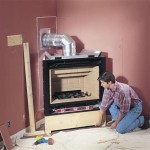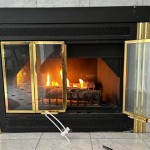The Cost of Fireplace Installation: A Comprehensive Guide
A fireplace can be a beautiful and cozy addition to any home, providing warmth, ambiance, and a focal point for gatherings. However, the cost of installing a fireplace can vary widely depending on several factors, such as the type of fireplace, materials used, and the complexity of the installation. Understanding the costs involved is crucial before embarking on a fireplace project.
Factors Affecting Fireplace Installation Costs
The cost of installing a fireplace is influenced by several factors, each contributing to the overall project expense. Here are some key considerations:
1. Type of Fireplace
The type of fireplace you choose has a significant impact on the cost. Here's a breakdown of common fireplace types and their approximate price ranges:
- Traditional Fireplaces: These are the most basic and often the least expensive, typically starting around $2,000. However, the cost can increase depending on the size, materials, and design elements.
- Gas Fireplaces: Gas fireplaces offer convenience and efficiency, but they are typically more expensive than traditional fireplaces, starting around $3,000. The cost can rise depending on the size, features, and type of gas used.
- Electric Fireplaces: Electric fireplaces are the most affordable option, typically starting around $500. However, they lack the authentic warmth and ambiance of traditional or gas fireplaces.
- Outdoor Fireplaces: Installing an outdoor fireplace involves additional considerations, such as weatherproofing, material choices, and permits. This can significantly increase the cost, ranging from $5,000 to $15,000 or more.
2. Materials Used
The materials used for the fireplace, such as the mantel, hearth, and surrounding finishes, can greatly affect the cost. High-quality materials like stone, marble, or custom-made elements will increase the expense, while budget-friendly options like brick or prefabricated surrounds will be less costly.
3. Installation Complexity
The complexity of the installation is another crucial factor. Installing a fireplace in an existing structure may involve extensive demolition, framing, and chimney work, which can significantly increase the cost. Additionally, special considerations like venting, gas lines, or electrical wiring can add to the expense.
4. Labor Costs
Labor costs for installing a fireplace vary depending on the location, experience of the contractor, and the complexity of the project. Hiring a specialized fireplace installer may be more expensive than a general contractor, but they bring expertise in fireplace design and construction.
Additional Costs to Consider
Beyond the basic installation costs, there are several additional expenses to consider when planning a fireplace project:
1. Permits and Inspections
Installing a fireplace often requires permits and inspections, which can vary in cost depending on local regulations. It's essential to obtain the necessary permits before starting the project and ensure compliance with local building codes.
2. Venting and Chimney Work
Venting systems are crucial for gas or traditional fireplaces to safely exhaust combustion byproducts. This can involve installing a new chimney, extending an existing one, or using a specialized venting system, all adding to the overall cost.
3. Gas Lines or Electrical Wiring
If installing a gas fireplace, you'll need to factor in the cost of running gas lines from the main source to the fireplace location. Installing an electric fireplace may require dedicated electrical wiring or circuit upgrades, which can add to the expense.
4. Fire Safety Equipment
Fire safety equipment, such as fire screens, fire extinguishers, and smoke detectors, is essential for every fireplace installation. These items add a small but crucial cost to the overall project.
Cost Saving Tips
While installing a fireplace can be a significant investment, there are strategies to manage the costs effectively:
1. Plan Carefully and Get Multiple Quotes
Planning the fireplace design, materials, and features in advance can help you make informed decisions and avoid costly changes later. Getting multiple quotes from reputable fireplace installers is also essential to compare prices and services.
2. Consider Alternatives and Budget-Friendly Options
Exploring alternatives like electric fireplaces or prefabricated fireplace surrounds can offer savings compared to custom-built options. Using budget-friendly materials like brick or stone veneer can also reduce overall costs.
3. Choose a Seasonally Appropriate Time for Installation
Installing a fireplace during off-peak seasons may result in lower labor costs due to reduced demand from contractors.
4. DIY Projects with Caution
Some DIY projects, like building a mantel or installing a fire screen, can be undertaken with proper knowledge and skills. However, complex tasks involving venting, gas lines, or electrical wiring should be entrusted to qualified professionals to ensure safety and compliance.
Installing a fireplace can enhance your home's comfort, ambiance, and value. By understanding the factors affecting costs, exploring cost-saving options, and working with qualified professionals, you can make informed decisions and enjoy the benefits of a fireplace without breaking the bank.

How Much Does It Cost To Put In A Fireplace Direct Fireplaces

ᑕ❶ᑐ How Much Do Fireplace Built Ins Cost Get The Guide

What Does It Cost To Install A Fireplace Vs Wood Stove Stamford Fireplaces

How Much Does A Gas Fireplace Cost Fireplaces Direct Learning Center

Estimated Page Fireplaces Stoves Inserts Wood Gas Pellet

Gas Fireplace S Installation Cost 2024 Oneflare

How Much Does A Gas Fireplace Cost Fireplaces Direct Learning Center

How Much Does Opening Up A Fireplace Cost In 2024 Checkatrade

How Much Does An Electric Fireplace Cost 2024 Data

2024 Fireplace Installation Costs Gas Wood Burning Electric
Related Posts








